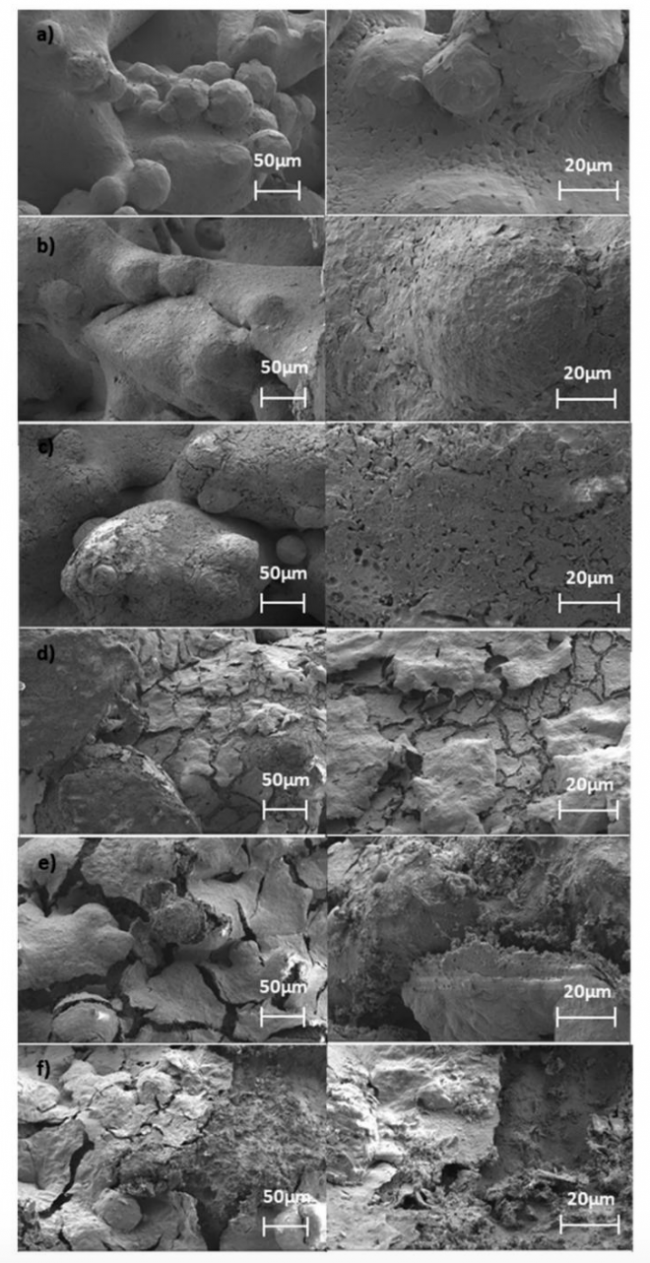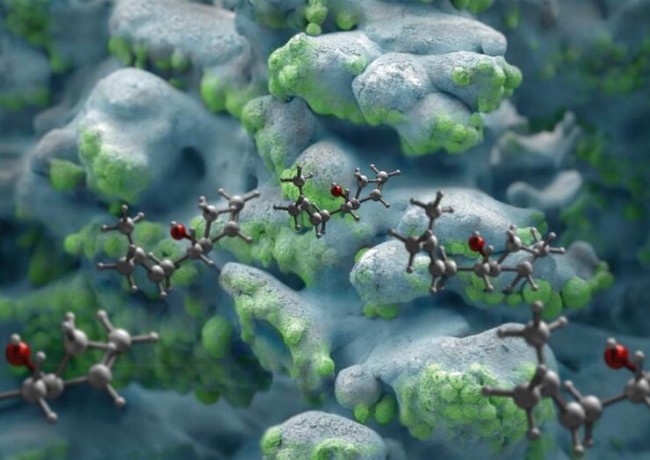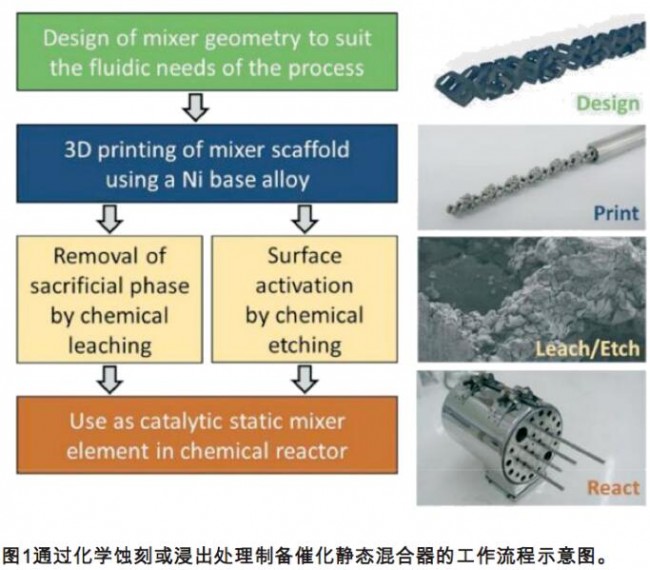3D printingComplex structures can be achieved for use in static mixers, thereby increasing the strength and performance of the reactor system. According to Baidu Encyclopedia, a static mixer is a high-efficiency mixing device without moving parts. Its basic working mechanism is to use the mixing unit fixed in the tube to change the flow state of the fluid in the tube to achieve good dispersion and full mixing between different fluids. the goal of. Static mixer is a kind of high-efficiency mixing equipment without motion. Through the mixing unit internals fixed in the tube, two or more fluids can be cut, sheared, rotated and remixed to achieve good dispersion and full mixing between the fluids. Purpose.
Through research by the FloWorks Group supported by the Commonwealth Scientific and Industrial Research Organisation (CSIRO) in Melbourne, Australia, this research combined additive manufacturing (metal3D printing) and subtractive (chemical etching) methods for the fabrication of a novel structured nickel catalyst static mixer for selective hydrogenation of fragrances. A related paper was published in Reaction Chemistry & Engineering under the title “3D printed nickel catalytic static mixers made by corrosive chemical treatment for use in continuous flow hydrogenation”. In this issue of Gu. Column, we will share this scientific research result.
![]() 3D printed static mixers: from ceramics to metals
3D printed static mixers: from ceramics to metals
A static mixer usually consists of three parts: the shell tube, the mixing unit inside the tube, and the flanges (or other connection methods) at both ends. The mixing process of the static mixer is carried out by a series of mixing units of different sizes installed in hollow pipes. Due to the action of the mixing unit, the fluid sometimes rotates to the left and sometimes to the right, constantly changing the direction of the flow mixer, which not only pushes the central fluid to the periphery, but also pushes the peripheral fluid to the center, resulting in a good radial mixing effect. At the same time, the rotation of the fluid itself will also occur on the interface of the connection between the adjacent components. This perfect radial circulation mixing effect enables the material to be mixed evenly.
The mixing unit inside the static mixer tube is a key part of the mixer function.shared ceramics3D printing technologyIn the application in the preparation of static mixers, ceramic materials are suitable for preparing internal channels of mixing units of mixers due to their comprehensive properties of high temperature resistance and chemical corrosion resistance. The main difficulty in current manufacturing is the use of high-performance ceramic materials to produce products with complex geometries such as internal mixing cells.
So in addition to ceramic materials, how can metals achieve chemical resistance?
So far,Metal 3D PrintingCan be used to make several nickel based alloy powders including Monel (Alloy 400) Hastelloy (Alloy C276, Alloy X) Inconel (Alloy 625, Alloy 718, Alloy 738) and many more. After 3D printing into the desired shape, it is chemically etched to form a nickel-rich surface layer with increased porosity and increased surface area, ultimately improving catalytic activity.
Australian researchers have developed a new method for making 3D-printed structural catalyst static mixers with etched layers that are porous but not significantly enriched in Ni or Cr. During both leaching and etching, the treatment is localized and has limited penetration depth into the 3D printed part, while greatly increasing the surface area and porosity within the newly formed layer, which greatly improves catalytic activity.
The researchers divided the subtractive manufacturing steps into a “leaching process” and an “etching process.” In general, leaching is defined as the selective removal of a sacrificial metal phase, here achieved by dissolution from the 3D printed alloy matrix, while leaving the “desired” catalytically active metal species (Ni in this case) intact. In this study, the researchers selectively leached copper from Monel, an alloy composed primarily of nickel and copper. The resulting leached surface layer is porous, rich in nickel and depleted in copper.
In contrast, etching removes and/or oxidizes several metal species from the 3D printing alloy matrix by dissolving in relatively equal amounts from the surface. This treatment produces a top layer with greatly increased porosity and surface area, while being non-selective to the individual metal species of the alloy. An example is the non-selective removal of nickel and chromium from Inconel, the two main components by weight of the alloy.
3D printed Inconel powder (Alloy 738) from Praxair. The metallic composition of this powder is ~61% Ni, 16% Cr, 8.5% Co, 3.4% Al, 3.4% Ti, 2.6% W, 1.8% Ta, 1.8% Mo, and small amounts of Fe, C, B, Zr , Mn, Si and S.
3D printed Monel powder (Alloy 400) from Micron Metals. The metallic composition of this powder is ~61% Ni, 35% Cu, 2.2% Fe, 1.3% Mn, and 0.5% Si.
![]() Inconel prepares nickel type catalytic static mixer
Inconel prepares nickel type catalytic static mixer
A nickel-based catalytic static mixer additively manufactured by Inconel (known as Ni‑Inc) was printed on the Arcam A1 electron beam melting 3D printer using Praxair’s Inconel powder whose machine process parameters were set experimentally of.
Arcam Electron Beam Melting (EBM) equipment uses an electron beam to melt and fuse metal powders layer by layer into 3D parts. The process takes place in a powder bed under vacuum, and Inconel’s typical starting bed temperature is 1050 °C, this is to gently sinter and stabilize the powder as it forms. The supports below the scaffolding are 0.5mm diameter and 3mm long support posts that aid the melting process to avoid the part swelling above the plane of the powder layer. After the 3D printing is complete, unmelted, slightly sintered powder is removed from around the mixer by sandblasting.
The 3D printed static mixer was then chemically etched with the solution, and the etching time was set to 5 minutes, 20 minutes, 2 hours, 24 hours, or 48 hours (at room temperature), resulting in different surface topographies. Each treated sample was washed with copious amounts of water, then ethanol, and then blown dry with nitrogen, and the mass loss of these samples was relatively low.
![]() Preparation of Monel Nickel Catalytic Static Mixer
Preparation of Monel Nickel Catalytic Static Mixer
A nickel-type catalytic static mixer was printed on an Arcam A1 electron beam melting 3D printer using Micron Metals powder. The machine process parameters for this powder were set experimentally.
A typical starting bed temperature for Monel is 600°C to allow for slight sintering of the powder as it is formed. The supports below the scaffolding are 0.5mm diameter and 3mm long support posts that aid the melting process to avoid the part swelling above the plane of the powder layer.
Chemical leaching of static mixers after sandblasting not only increases surface porosity but also selectively removes copper. Four Monel mixers were placed into 450 mL of 2M ammonium sulfate and 5M ammonia solution for 10 days with at least 1 hour of sonication per day. Add 30 mL of ammonia water every three days to replace the ammonia lost as a gas. The mixture was observed to turn pale green. The mixer was then washed thoroughly in water and protected into a separate 450 mL of 2M ammonium persulfate and 5M aqueous ammonia.
This solution was left for an additional 12 days, applying the same sonication and ammonia replenishment protocol as above. The persulfate mixture was observed to turn sapphire blue, then washed with copious amounts of water and ethanol, and air-dried for an additional four days.
 SEM images of Inconel samples at different etching times. Each row contains image magnifications of the same sample at two different locations (left: 250×, right: 1000×) a) untreated Inconel; b) etched Inconel after 5 minutes; c) 20 minutes Post-etch Inconel; d) Inconel etched after 2 hours; e) Inconel etched after 24 hours; f) Inconel 48 hours after etch.
SEM images of Inconel samples at different etching times. Each row contains image magnifications of the same sample at two different locations (left: 250×, right: 1000×) a) untreated Inconel; b) etched Inconel after 5 minutes; c) 20 minutes Post-etch Inconel; d) Inconel etched after 2 hours; e) Inconel etched after 24 hours; f) Inconel 48 hours after etch.
Compared to the Inconel static mixer treatment, this leaching scheme primarily removes copper from the 3D printed part, thereby enriching the remaining layer with nickel.
After chemical treatment, each set of static mixers was activated with hydrogen.
Overall, 3D printing provides structural integrity as well as an activated porous top layer, both made of the same corrosion-resistant nickel-based alloy. The fabrication method contrasts with most other nickel catalysts, which are typically made from expensive precursor materials and require the use of complex porous support materials, binders, ligands or other additives. 3D printed catalyst static mixers offer the advantages of low pressure drop and low risk of clogging, which are especially important for industrial continuous flow operations.
(responsible editor: admin)




0 Comments for “3D printed new structured nickel catalyst static mixer for selective hydrogenation of fragrances”